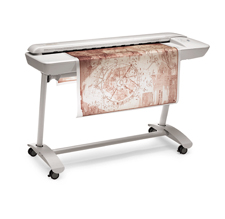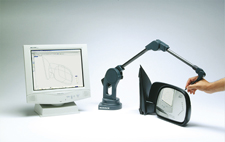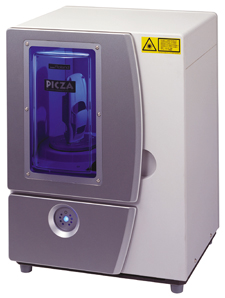Digitize and Scan—Designs Get New Life
Three experts tell us what to consider before making a purchase, and providesome useful insight into the technologies.
Latest News
August 1, 2004
By Susan Parran
Digitizers and scanners are close cousins in the design engineering arena. Bydefinition, a digitizer is a device used to convert analog data into digital formor, simply put, a series of dots that can be read by a computer, stored, and latermanipulated with software. A scanner, on the other hand, reads hard data, photographicimages, and illustrations. That data is then translated into a computer-readableformat and stored. Once again, it can then be manipulated using various programs.This article will focus on those systems used by design engineers to produce andinspect parts within a CAD environment.
 Some Things To Keep In Mind When Shopping
Some Things To Keep In Mind When Shopping Digitizers come in many shapes and sizes from tablets and desktop versions tofree-standing models and systems with moveable arms that can rotate around a stationaryobject. So what factors should you consider before buying? Depending upon yoursituation, certain scanning systems will be more appropriate than others.

Immersion’s MicroScribe G2 desktop digitizing system works with many differentCAD/CAM packages.
Size should play a factor in your decision. Greg Belaus, Senior Director of 3Dand Professional Products at Immersion Corporation, a developer of touch-feedbacktechnology and input systems based in San Jose, California, says, “there are avariety of sizes to choose from.” In the case of Immersion’s scanners, “shorterarms can be used to daisy-chain pieces of geometry together to form a large digitalmodel, if needed.”
View the Scanner and Digitizer Resource Guide Chart
Along with size, stresses Belaus, ease of use is an important aspect of digitizingtechnology. He notes that digitizing systems can be applied in many differentenvironments, so “they are generally immune to environmental variables such aslight sources or magnetic fields.”
Another important consideration is accuracy. “There are many accuracy levelsto choose from, and it’s most cost-effective to choose the one that is appropriateto the project at hand,” says Belaus. And, he adds, “through plug-ins, digitizingtechnology is becoming more and more integrated with the popular CAD/CAM softwarepackages,” so integration should play a role. “Data is saved in the software package’sformat. Lines, curves, circles, and other geometries transfer into the softwareapplications as standard entities recognized by that system.” These parts, saysBelaus, can then “be edited and used in the same ways that shapes generated bya mouse and keyboard can ]and] there is no difference. The digitized data is thensaved in the format of the host application and can be used by any system runningthat software.”
Roland DGA Corporation’s LPX-1200 scanner.
Scanners Get the Lead OutAs with purchasing a digitizer, carefully assess your needs before deciding ona scanner for your organization. Whether you choose one that uses a laser to projectlight onto a surface and triangulates an object’s profile, or decide on a scannerthat uses “white light” technology, scanners enable a user to capture “complexsculpted surfaces…that are not possible to create in CAD.” That’s the assessmentof David Olson, Senior Sales and Marketing Consultant at Roland DGA Corporationin Irvine, California. “Understanding the reverse modeling process that is appropriatefor the industry application is the key to completing projects faster and cheaper.”
Automated scanners eliminate the need for skilled engineers to manually acquirescan data. “Design organizations should look for scanners that include fully automatedrotary and planar scan modes for high accuracy with minimal labor,” says Olson.Such automated scanners make it possible for design engineers to perform othertasks while the machine scans the object. And, Olson cautions: “Scanners thatrequire manual operation to capture points and surfaces are labor intensive andthe resultant data is subject to human error.”
Olson cites hardware and software prices as a major barrier to the widespreadimplementation of scanning technology. “Most CAD applications are NURB-based,“he says, “so the biggest challenge for the design engineer is reverse modelingthe geometry in a way that translates the polygon mesh surfaces into useful NURBsurfaces,” and to do it without it costing a lot of money. Olson provides a typicalreverse modeling scenario as an example of this process:
- Scan and capture point cloud data
- Convert data to polygon surfaces
- Identify and delete unwanted data
- Align and merge polygon surfaces
- Fill holes and smooth surfaces
- Convert to NURB surfaces; save as IGES file
- Import IGES file into CAD/CAM application of choice.
Bill Mitchell, a product manager, for GTCO CalComp in Columbia, Maryland, says,“at one time, it was estimated that 80 percent of all new designs came from existingdesigns.” Regardless of whether the estimate is accurate, many new designs arebased on designs that exist on paper. As manufacturers design new products orimprove existing products that were not originally created electronically, “scanningoriginal engineering drawings is and will continue to be the most efficient wayto bring legacy data into the digital design world.”
Mitchell believes it is important to have a device that will capture images ina reasonable amount of time and “produce results that are at least as good asand, in most cases, better than the document that is being scanned.” This is bestaccomplished, he says, by high-res olution hardware, and scanners with increasedcolor depth.
According to Mitchell, “service bureaus will have more of a tendency to selectscanners that have faster scanning speeds due to the continuous demands that arenormally placed on them by their customers.” In-house, project-based scanningdoesn’t usually have such critical deadlines and might not require the fastestscanning speeds. Reliability, ease of maintenance, and serviceability though,are important aspects.
Lower Costs Spreading the WealthBelaus says digitizing technology is becoming easier to use and less expensive.What this means is that, “rather than one unit per department, the devices willbe able to sit on each engineer’s desk,” he says. “And instead of being reservedfor big, special jobs, digitizers can be used for smaller, more routine projectsand any type of physical measuring…in most cases the devices are integrated withsoftware that the engineer already uses on a daily basis. This keeps the learningcurve short.”
“The holy grail for design engineers,” says Olson, lies in the ability to “scanan object and get a fully featured, parametric CAD model ]engineers] can editin their CAD software of choice.” He adds, “the beauty of this reverse modelingprocess is that the original scan data doesn’t have to be extremely accurate ifthe parametric CAD feature can be edited later. The first vendor to deliver thistype of functionality will make a lot of design engineers very happy.”
Susan Parran is associate editor for Desktop Engineering. To comment on this article, sendmail to Susan via Desktop Engineering Feedback.
Standards on the Docket
A technical working group is being formed to discuss industry standards and practicesas they relate to reverse engineering and rapid prototyping. Doug Mitchell, DevelopmentEngineer at Ford Motor Company, will chair the group and its findings will behosted at the Society of Manufacturing Engineers (SME) website.
If you’re interested in finding out more, visit sme.org.
Subscribe to our FREE magazine, FREE email newsletters or both!
Latest News
About the Author
DE’s editors contribute news and new product announcements to Digital Engineering.
Press releases may be sent to them via [email protected].






